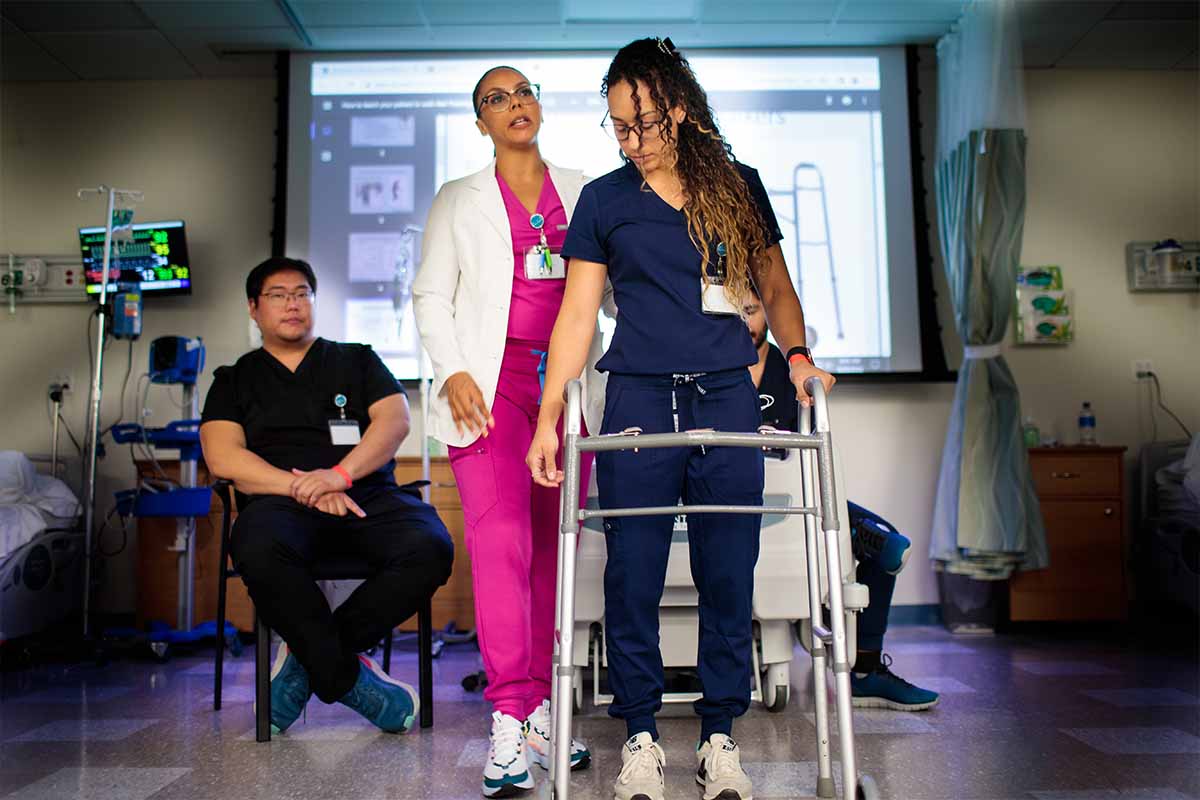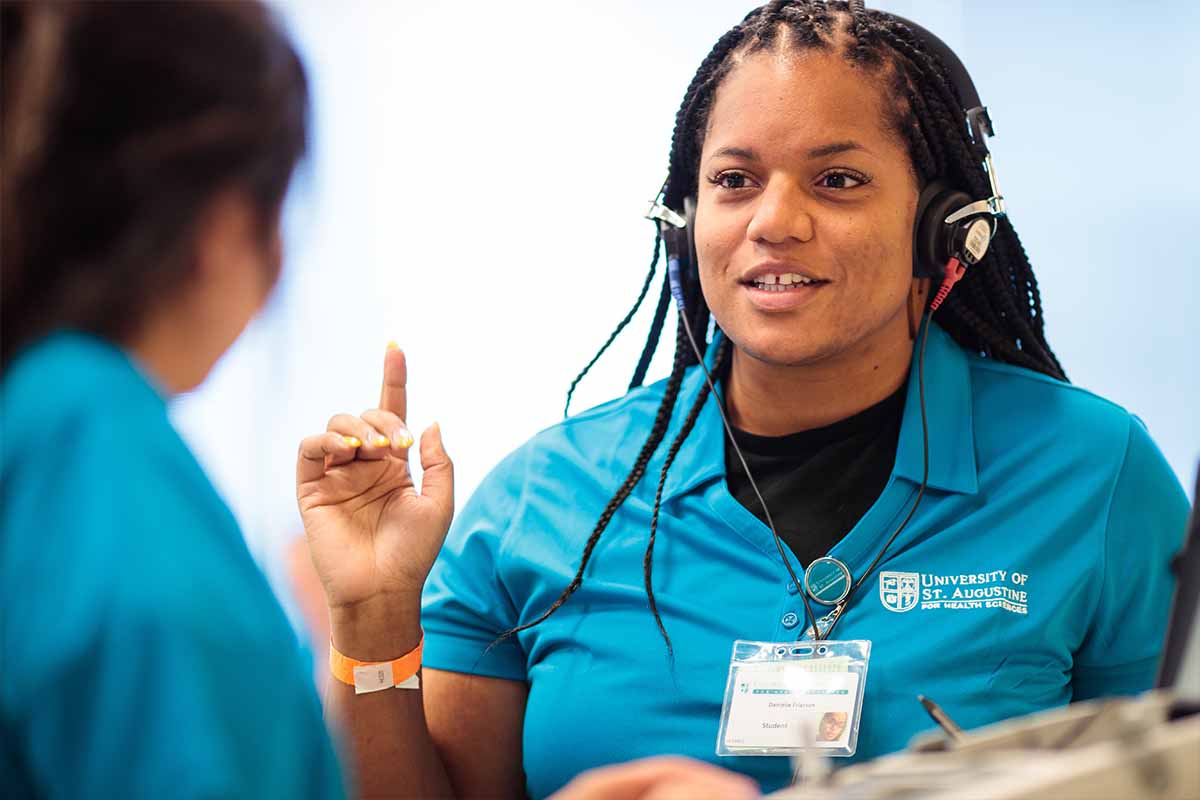
USAHS faculty and staff led a robust schedule of presentations at the International Meeting on Simulation in Healthcare (IMSH) 2020. Sixteen of our faculty and staff members participated in eight presentations at this renowned annual simulation conference in San Diego, which took place January 18–22. Faculty presented about the variety of ways they are using simulation in laboratory courses in our occupational therapy, physical therapy, speech-language pathology, and other graduate degree programs.
Leading the Way in Simulation
“We are leading the way in simulation, especially for rehabilitative sciences,” says Elisabeth McGee, DPT, MOT, manager of the University’s Centers for Innovative Clinical Practice (CICPs). The CICPs are our state-of-the-art simulation labs, where students gain hands-on practice treating mock patients in realistic scenarios. Dr. McGee continues, “So much of simulation has been dominated by the fields of nursing, medicine, and aviation. We’re contributing a new angle.”
Maureen Johnson, PhD, OT/L, an assistant professor of OT known as “Dr. Mo,” says the USAHS presentations focused on how simulation “teaches students safe techniques, deeper critical thinking, and the ability to be flexible during an evaluation.”
Our Presentations
Here’s a selection of the presentations our faculty and staff gave to an audience of their peers, who are healthcare educators teaching through simulation in universities and hospitals.
First-Term PTs and OTs Learning Together
Dr. Mo and her colleague Norman Belleza, PT, DPT, teach a course for all first-term OT and PT students that features several interprofessional simulations. At the conference, they led participants through a workshop that included the course’s first simulation activity: a scavenger hunt in an escape room, in which students work together to match pieces of OT and PT equipment with their technical terms, then find the password to escape the room. “It was very well received,” Dr. Mo says.
Expanding Professional Skills and Clinical Reasoning Through Simulation
Kathleen Manella, PT, PhD, and three colleagues presented on how they organized a 75-minute simulation plus a 30-minute debrief for up to 70 DPT students, in which every student gets to participate. The simulation involves six color-coded teams, with 12 students and one instructor per team. Every student gets to play each of the following three roles: a PT evaluating a patient, a PT tech or assistant, and the patient. Three sims run at once. “The audience was in awe,” Dr. Manella says. “They couldn’t believe we figured out how to do this.”
Making Equipment for Simulations
Dr. McGee and four colleagues led a hands-on workshop on creating a DIY task trainer using common low-cost molding and moulage (fake wound) material. (Task trainers are specialized simulators or models that help the learner practice a specific skill.) Working in teams, attendees had the chance to create a task trainer and a type of moulage to help students learn how to treat second-degree burns, abscesses, cuts, bruising, necrotic tissue, and more.
Online Simulations for Distance Students
Dr. Jordan Utley, Dr. McGee, Dr. Robin Dennison, and Dr. Karen Snyder collaborated on a presentation about moving face-to-face (F2F) clinical scenarios online. With a video as illustration, they recounted how their team collaborated to create an engaging and interactive online interprofessional simulation for distance-based participants. They discussed how they constructed the online format, including a pre-brief, simulation, and debrief.
Roleplays About Global Health Trips
Healthcare workers who go on short-term medical service trips can benefit from pre-departure training addressing cultural and economic disparities they may encounter. Sharon Dunnivan-Mitchell PT, DPT, and Suzanne Trotter, PT, ScD, led a workshop about how to use simulation and roleplays to prepare healthcare providers for the cultural differences they will encounter—and practice responding in a sensitive way.
Simulation for Large Groups
Dr. McGee and Elizabeth Horsley, RN, MSMS, Director of Simulation at the Brooklyn Hospital Center, spoke about how to facilitate effective and meaningful simulation for large groups of 20–30+ students. They gave an overview of current literature and identified best practices for maximizing the simulation experience for student observers.
Faculty Perceptions of Simulation
Dr. Mo presented a poster of her PhD dissertation, which was about USAHS faculty attitudes toward simulation-based teaching and how they have evolved over time. “When our CICPs were being constructed in 2017, my colleagues were being told they needed to teach differently,” she says. “Their first thoughts were something like, ‘This is ridiculous, it’s never going to work, it’s a waste of time.’” Dr. Mo studied the evolution of faculty perceptions, until they started saying, “This is amazing” and “How come we never taught like this before?”
From Learners to Leaders
2017 was the first year that USAHS faculty attended the IMSH conference. “The conference was about, ‘this is how MDs, military, and aviation are doing it,’” Dr. Mo says. “There was zero rehab. It was great info—but we wondered, what do we do with it?” That same year, USAHS faculty and administrators started planning and building the CICPs across campuses. Faculty started integrating simulation into program curricula, including interprofessional simulations tied to measurable outcomes.
At the 2018 conference, faculty gave a short presentation. In 2019, they gave two presentations. “Each time we have been more of a presence,” Dr. Mo says. “But this year, all of our proposals were accepted—eight presentations! We’re getting that respect level now. Our peers see us as a thought leader in the rehab simulation space.”
She notes that some USAHS programs are seeing a 79% growth in simulation hours each term. “We wanted to share our journey with the audience. First we were learners; now we are leaders.”
“We’re still in communication with some audience members,” she says. “They asked us advice for adapting activities to their setting. I think our presentations, especially our presentations on interprofessional education led by Dr. Norman Belleza, really opened up awareness among participants of the role of simulation in the rehabilitative sciences.”










